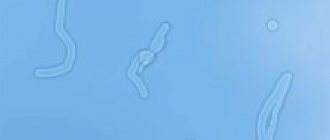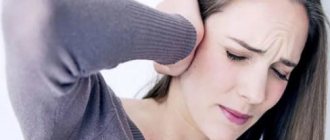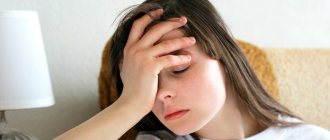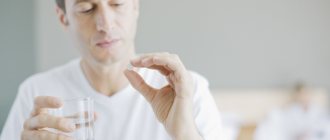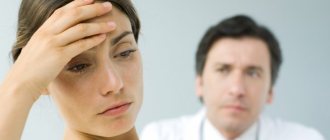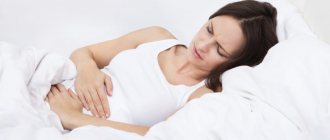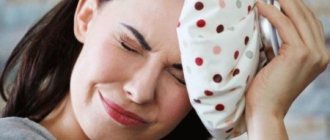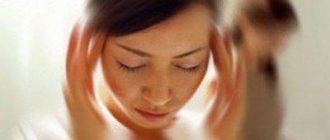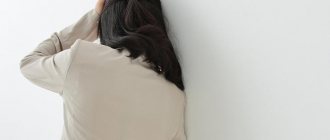Nowadays, headaches have become a constant companion for many. People prefer to stop attacks of cephalalgia with the help of painkillers. Few people wonder why pain occurs, and even less often turn to doctors for help.
However, this problem should not be ignored. Pain in the crown may indicate the presence of serious diseases, untimely treatment of which leads to negative health consequences.
Symptoms of cephalalgia
A headache is an unpleasant, debilitating condition. The symptoms of pain vary. Some symptoms can be easily eliminated with medication, but there are others that require consultation with a doctor. Immediate medical assistance is required in cases where pain is accompanied by:
- Balance imbalance.
- Disorientation.
- Rapid loss of vision.
- Severe dizziness.
- Changes in blood pressure.
- Continuous vomiting.
- Memory impairment.
- Temperature increase.
- Dryness of the mucous membranes in the mouth.
- Loss of consciousness.
A headache that does not go away after taking painkillers and is caused by a head injury should not be ignored.
If the pain in the crown does not go away for a long time, you should visit a therapist. He will offer to undergo an examination to identify the causes of negative processes. If necessary, the medical professional will refer the patient to other specialists.
Causes of cephalalgia in the vertex area
Pain in the upper part of the head in most cases occurs for the following reasons:
- Hypertension. It can cause severe pain in the parietal part. Accompanied by surges in blood pressure.
- Nervous strain and prolonged stress cause dull pain in the upper part of the head. Painful sensations are more common in people over 31 years of age who are under constant stress due to the specifics of the work process.
- The parietal area of the head may hurt if there is a disease of the spine, especially the cervical region. The pain syndrome is of an increasing, acute nature. The pain intensifies with sudden turns of the head.
- The rapid formation of osteophytes, which occurs in older people and those who lead an unhealthy lifestyle, can provoke the development of chronic headaches.
- Myogelosis is a condition in which dystrophic changes occur in the muscles, accompanied by circulatory disorders and fibrosis. The inability to relax the muscles of the cervical spine, moderate pain in the back of the head and crown are the main symptoms of the disease.
- Neuralgia is damage to the nerves, accompanied by piercing, acute pain at the site of their innervation. Causes of pathology: stress, intoxication, neoplasms, injuries, inflammatory processes.
- The parietal part of the head, the temples and the back of the head may hurt during a migraine. The disease cannot be treated. The pain syndrome is relieved with the help of medications. The development of attacks can be prevented using preventive methods.
- Head injuries often lead to pain in the crown area. After an injury, you should consult a doctor. Untimely treatment of the consequences of mechanical damage to the brain can cause tumors, epilepsy, and vision problems.
- Cluster pain appears in one area, most often the crown of the head, and lasts no more than an hour. Mature men and women suffer from painful sensations during menopause and menopause.
- Neoplasms localized in the brain. Symptoms of the pathology: weakness, fever, blurred vision, convulsions, nausea, headache in the forehead, temples, crown.
- Vascular pain caused by hypotension, stress, VSD. Vasospasm leads to paroxysmal, severe pain localized in the crown, forehead and temples.
Preventive actions
It is difficult to completely get rid of headaches, especially if they are pathological. You can reduce the number of attacks if you follow a number of simple rules.
- Active lifestyle.
- Alternation of rest and work.
- Proper nutrition including a large number of fruits and vegetables, reducing fatty, spicy foods. Avoid fast food products. Vitamin B12 can prevent headaches. It is found in foods such as broccoli, nuts, and eggs.
- Healthy, long sleep of at least 7 hours a day.
- Avoiding conflict and stressful situations.
- Getting rid of bad habits. Alcoholic drinks cause increased blood pressure.
- You cannot sit in one position for a long time, especially when your shoulders are raised and your chin is down. The vessels of the neck are compressed.
Regular preventive examinations of the spine and brain will help prevent unpleasant symptoms associated with headaches.
A headache knocks a person out of his usual life. Sometimes simple, uncomplicated measures help get rid of it and prevent its reoccurrence.
Diagnostics and therapy
What to do if the upper part of your head constantly hurts? First of all, you should contact a therapist who will prescribe a series of examinations. The most effective diagnostic methods for headaches are as follows:
- CT.
- MRI.
- X-ray of the spine.
- General analysis of urine and blood.
- Pressure measurement.
- Collection of complaints.
- Examination by specialized specialists: traumatologist, psychiatrist, ophthalmologist, neurologist.
Therapy for headaches is carried out after identifying the causes that caused them, analyzing the person’s condition and his age. Treatment consists of taking medications, performing relaxation and physiotherapeutic procedures.
Treatment of pain syndrome involves taking medications such as:
- Askofen, Citramon - for hypotension.
- Captopril, Farmadipin - for hypertension.
- Sedalgin – for cluster pain.
- Minerals and vitamins - for migraines.
- Antidepressants - for neuroses.
- Nurofen, Ibuprofen, Spazmalgon - if you have a paroxysmal headache from above.
Medicines should be taken after a doctor's prescription. Self-medication can lead to diarrhea, dizziness, nausea, and vision problems.
Traditional medicine to protect health
Simple remedies that our ancestors used can reduce the intensity of attacks and spasms.
Effective traditional medicine recipes:
- The easiest way to relieve pain is cabbage leaf. Apply to the problem area for 30 minutes.
- Place your feet in a bowl of hot water. The procedures help to quickly eliminate acute spasms, especially if cold is applied to the head.
- Herbal soothing decoctions - effectively neutralize aching pain: marjoram, mint and medicinal valerian.
- Relaxation: massage, yoga, spa treatments and aromatherapy - lavender, sage, marjoram or mint.
- Beads and bracelets made of amber are good for relieving migraine attacks.
- Cucumber masks, lemon or orange peel. You can simply eat citrus - it helps reduce the intensity of pain.
If, after diagnosis, the general practitioner has not determined why the top of the head hurts, for additional examination he will prescribe a consultation with specialized specialists - a neurologist or psychotherapist, and MRI diagnostics.
Auxiliary treatment
As an addition to the main treatment, therapy with medications and procedures is possible:
Decoctions and tinctures of medicinal herbs
Preparations made from natural ingredients can be purchased at a pharmacy or made independently. The most effective remedies for pain in the crown area include:
- St. John's wort. Has a weak analgesic effect. However, if the pain syndrome is mild or caused by fatigue, then a remedy based on a medicinal plant can help. To prepare the infusion you will need: 200 ml of boiling water, 2 teaspoons of St. John's wort herb. The dried plant is poured with water and left for about 16 minutes. The infusion should be drunk 100 ml three times a day immediately before meals. In order to relieve pain, it will be enough to use the product for four days.
- Chamomile. This plant grows everywhere. It is better to procure raw materials in environmentally friendly places or purchase them at a pharmacy. If the crown of your head hurts, you should prepare a decoction of 2 teaspoons of dried, crushed chamomile and a glass of boiling water. The herb is infused for 19 minutes. For five days, drink 70 ml of the product immediately after meals.
- Peony. You can purchase a ready-made tincture at a pharmacy or make it yourself. To prepare the product at home, you will need 100 g of peony root and a liter of vodka. For three days you need to drink a teaspoon of tincture before meals. The three-day course should not be exceeded.
- Collection of herbs. The product contains: lilac, thyme, cornflower. All ingredients are taken in equal quantities, poured with boiling water and infused for 19 minutes. The drug is drunk in two doses with an interval of 50 minutes. The decoction is consumed daily until the pain in the parietal part completely goes away.
Essential oils
The most effective oils are rosemary, lavender, mint, sage, oregano, and rose. To achieve optimal results, before performing aromatherapy, you need to identify the cause of pain in the head.
- For sinusitis, inhalations with eucalyptus, lavender and rosemary oils have a good effect.
- If the top of your head hurts after a hard day, then mint and lavender oils will help relieve fatigue. A cold compress made from lemon, lavender, and chamomile oils added to a small amount of water will help relieve sudden pain.
- For migraines, rubbing a mixture of wormwood, mint and lavender oils into the temporal area will help.
- Chronic pain can be easily relieved with massage. You need to mix a few drops of lavender and chamomile oil with a small amount of olive oil. Apply the resulting cocktail to the neck and shoulders and rub gently in a circular motion.
Clay wraps
Wraps help relieve even severe migraines. They are effective for preventive purposes. There are several recipes:
- Add water to a small amount of clay until you get a creamy slurry. Place the product on gauze and apply to the forehead. Compresses should be done daily before bed. The duration of the procedure is 19 minutes. The course of treatment is a month.
- Mix 4 teaspoons of mint tincture, 100 ml of water and 100 g of clay. Place the product on gauze and apply to the forehead. The procedure lasts no more than 14 minutes. Compresses are used as first aid for cephalalgia.
- If you have a headache on the top of your head after a sleepless night or a hard day, a compress of a few drops of menthol and clay mixed with water will help. The procedure should last no more than 4 minutes.
Plant herbs
In Ayurveda (one of the oldest systems of medicine), it is customary to treat diseases with the help of herbal remedies. Philosophical teaching believes that pain localized in the head is divided into those that occur from inflammatory diseases and those whose nature does not have a clear etiology. If you have a headache on the top of your head, and no reason for its occurrence has been found, you should try using Ayurvedic medicine:
- For pain caused by otitis media, sinusitis or other infectious diseases, you need to inhale calamus root, crushed to a powdery state. Lubricate the forehead with eucalyptus essential oil, and the temple area with ginger paste. At the same time, you need to take laxatives. Ayurvedic medicine believes that pain is a consequence of overload of the nervous system. Cleansing the intestines helps to quickly restore human health.
- If the top of your head hurts, then you need to take milk thistle extract, 4 teaspoons of aloe juice per day, and also drink tea based on rhubarb root.
- If the pain is intense and accompanied by depression, insomnia, and increased irritability, Ayurveda suggests rubbing lavender and chamomile oils into the back of the head, drinking decoctions based on valerian roots, doing a massage with sesame oil, and then taking a contrast shower.
During treatment, a person must adhere to a diet. Avoid eating fruits high in fructose, pickled and fried foods, and avoid smoking tobacco and alcohol. Raw vegetables should predominate in the diet.
Acupuncture
This is an effective method, recognized by traditional medicine, which is carried out by inserting special needles into points on the body. These days there are many different schools and trends in acupuncture.
Before the session, you must undergo an examination to find the reasons causing pathological changes in the body. Acupuncture is carried out in sessions and has a number of advantages over other methods:
- By influencing active points of the head, it eliminates the causes of pain.
- Improves the general condition of the patient.
- Increases immunity.
Relaxation therapy
Relaxation therapy is the art of relaxation and is a good way to relieve nervous tension and stress. Thanks to it, you can achieve good results in the treatment of various diseases and their prevention, since many diseases are psychosomatic in nature.
This method consists of individual work with a psychologist and the application of Tibetan practices of energetic influence on the body, through the projection of various images, symbols, and the use of self-regulation practices.
This method of therapy improves the patient's mental state. During the session it is necessary to use classical music. During the period of exacerbation, it is best for the patient to remain calm and try to avoid external irritants.
What causes pain on the top of your head? Such a symptom may indicate the development of pathological processes in the body, overwork, improper daily routine, or the presence of bad habits. Cephalgia can be quickly treated only after a correct diagnosis has been established and a specialist has prescribed medications and auxiliary methods of therapy.
